BEIRUT: Militants from the Daesh group rioted in a northeast Syrian prison Sunday, a month after similar violence at the facility allowed four extremists to escape, an opposition war monitor and a Kurdish activist collective said.
Kurdish forces sent reinforcements to the prison in the eastern Hassakeh province and US military helicopters flew overhead, according to the Syrian Observatory for Human Rights, a Britain-based war monitor, and North Press Agency, a media platform operating in the Kurdish-administered areas.
Kurdish authorities currently operate more than two dozen detention facilities scattered across northeastern Syria, holding about 10,000 Daesh fighters. Among the detainees are some 2,000 foreigners whose home countries have refused to repatriate them, including about 800 Europeans.
Further details were not immediately available on the size of the riot, and it was not clear if the unrest was triggered by concerns about the coronavirus’s potential spread in the prison.
In late March, two days of riots broke out at the same facility when former Daesh members began knocking down doors and making holes in the walls between cells. Four prisoners escaped but were caught a day later.
The riots were put down by the Kurdish-led, US-backed Syrian Democratic Forces. Afterward, the SDF’s top commander Mazloum Abdi urged the home countries of foreign fighters to find a solution for the prisoners. The riot was one of the most serious uprisings by the prisoners since Daesh was defeated a year ago, when the SDF seized control of the last sliver of land controlled by the extremists in eastern Syria.
A resurgence of Daesh attacks in both Syria and Iraq has raised concerns that the militant group is taking advantage of governments absorbed in tackling the coronavirus pandemic and the ensuing slide into economic chaos.
Last month, the US-led coalition said it had handed over hygiene and medical supplies to detention facilities across northeastern Syria, such as hand-washing stations, disinfectant wipes, face masks and examination gloves.
One coronavirus death was reported in Kurdish-held areas of Syria in April. The central government in Damascus has registered 43 cases and three deaths.
Daesh prisoners riot again in northeast Syria
https://arab.news/2yarx
Daesh prisoners riot again in northeast Syria

- Kurdish forces sent reinforcements to the prison in the eastern Hassakeh province and US military helicopters flew overhead
- Further details were not immediately available on the size of the riot
Explosive remnants of Syrian civil war pose a daunting challenge

- Unexploded ordnance and landmines threaten civilians, with children most at risk of death or injury
- As displaced Syrians return, accidents are expected to rise due to inadequate clearance, experts warn
INNUMBERS
* 324,600+ Unexploded bombs and landmines contaminating Syrian Arab Republic.
* 350 Civilians maimed or killed by UXO in Syrian Arab Republic since Dec. 8, 2024.
* 116 Children killed or injured by explosive debris in Syrian Arab Republic in December 2024.
* 3,471 Civilians killed by landmines in Syrian Arab Republic since 2011.
*$40m Funds needed by Syrian Arab Republic for disposal operations per year.
Sources: Carter Center, HALO, UNICEF, SNHR
ANAN TELLO
LONDON: The sudden fall of Bashar Assad’s regime in early December prompted around 200,000 Syrians to return to their war-ravaged homeland, despite the widespread devastation. But the land they have come to reclaim harbors a deadly threat.
Almost 14 years of civil war contaminated swathes of the Syrian Arab Republic with roughly 324,600 unexploded rockets and bombs and thousands of landmines, according to a 2023 estimate by the US-based Carter Center.
In the last four years alone, the Syrian Arab Republic has recorded more casualties resulting from unexploded ordnance than any other country, yet no nationwide survey of minefields or former battlefields has been conducted, according to The HALO Trust.
Those explosives have maimed or killed at least 350 civilians across the Syrian Arab Republic since the Assad regime fell on Dec. 8, Paul McCann, a spokesperson for the Scotland-based landmine awareness and clearance charity, told Arab News.
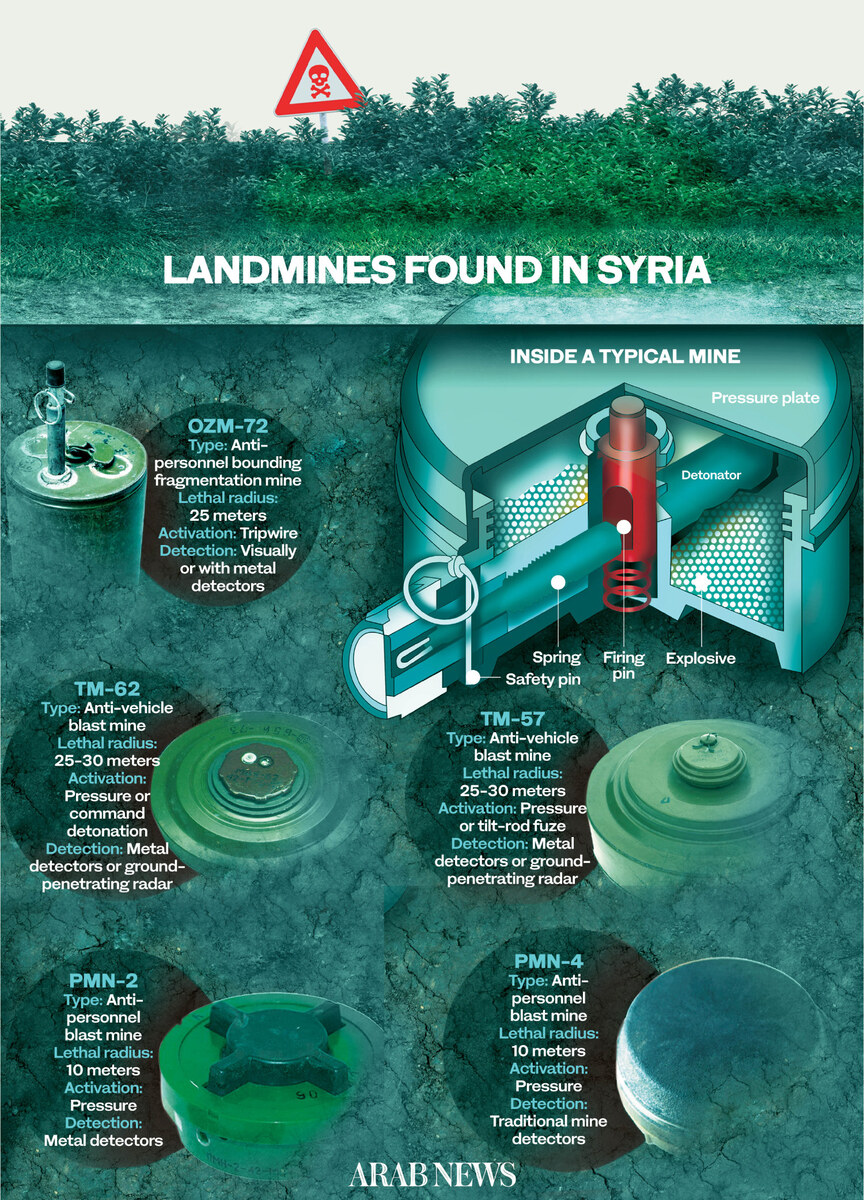
The actual toll, however, is likely much higher. “We think that’s an undercount because large areas of the country have no access or monitoring, particularly in the east,” he added.
Children bear the brunt of these hidden killers.
Ted Chaiban, deputy executive director for humanitarian action and supply operations at the UN children’s agency, UNICEF, warned that explosive debris is the leading cause of child casualties in Syria, killing or injuring at least 116 in December alone.
According to McCann, the bulk of the documented incidents involving landmines and unexploded ordnance took place in Idlib province, north of Aleppo, and Deir Ezzor, where intense battles between regime forces and opposition groups had occurred.
“There is a long frontline — maybe several hundred kilometers — running through parts of Latakia, Idlib, and up to north of Aleppo, where the government was on one side, and they built large earthen barriers,” he said.
“They used bulldozers to push up big walls and dig trenches, and in front of their military positions they put a lot of minefields.”
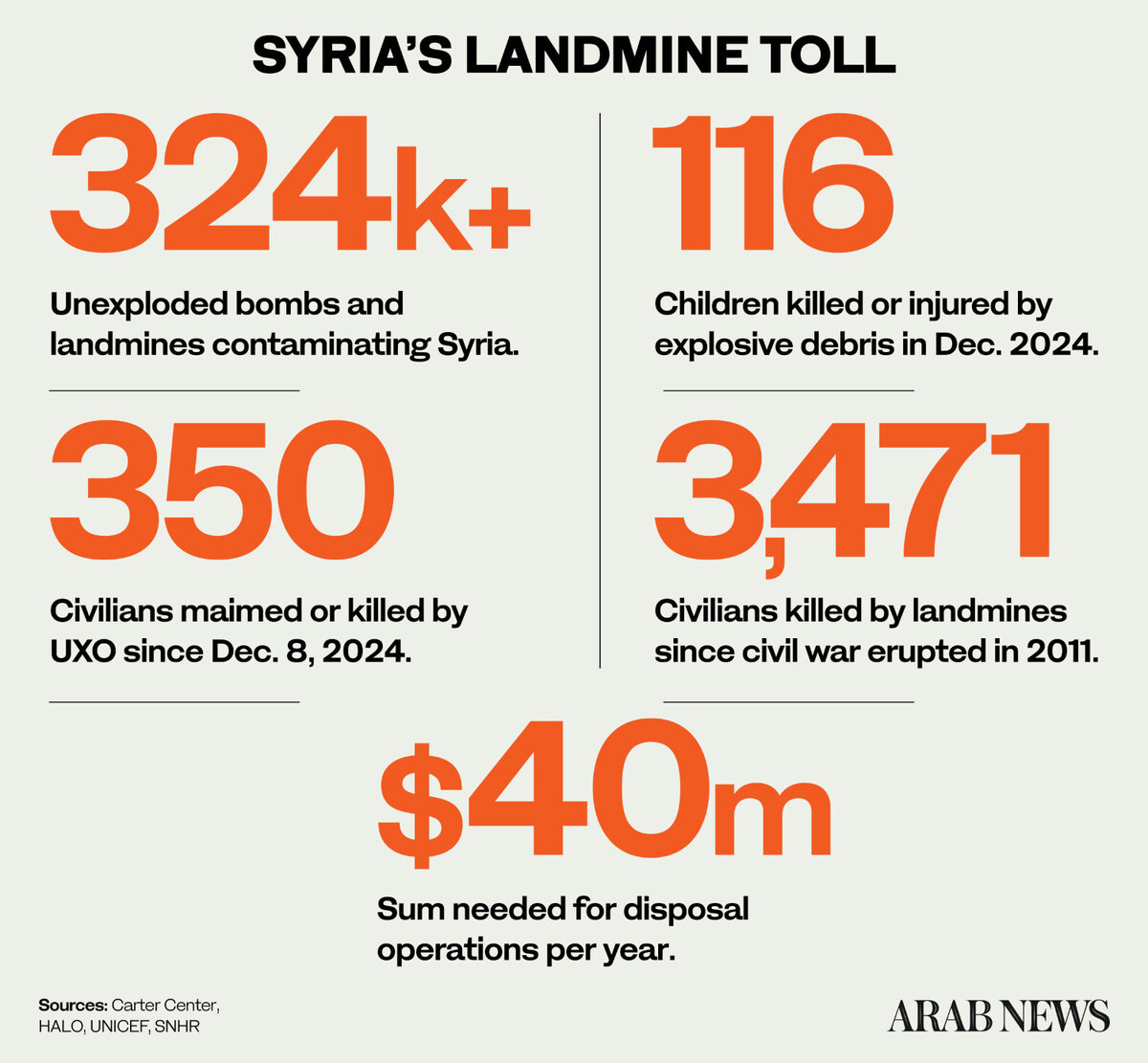
McCann said the exact number of landmines, across the Syrian Arab Republic and in the northwest specifically, remains unknown. “We don’t know exactly how many, because there hasn’t been a national survey,” he said.
After the regime’s forces withdrew from these areas, locals discovered maps detailing the location of dozens of minefields. Although it will take time and resources to clear these explosives, such maps make containment far easier.
“There was a battalion command post, and when the troops left, local residents went in and found some maps of local minefields,” McCann said. “So, for that one area, we’ve discovered there were 40 minefields, but this could be repeated up and down this line for all the different military positions.”
Landmines planted systemically by warring parties are not the only threat. HALO reported “huge amounts of explosive contamination anywhere that there might have been a battle or been any kind of fighting.”
One such area is Saraqib, east of Idlib. The northwestern city endured a major battle in 2013, fell to rebel forces, was recaptured by the Syrian Army in 2020, and was then seized during the Hayat Tahrir Al-Sham-led offensive on Nov. 30.
“The city was fought over by the government and multiple different opposition groups, who sometimes fought each other,” McCann said. “And in a big spread south of there, there are dozens of villages that we’ve been through which are contaminated with explosives.”
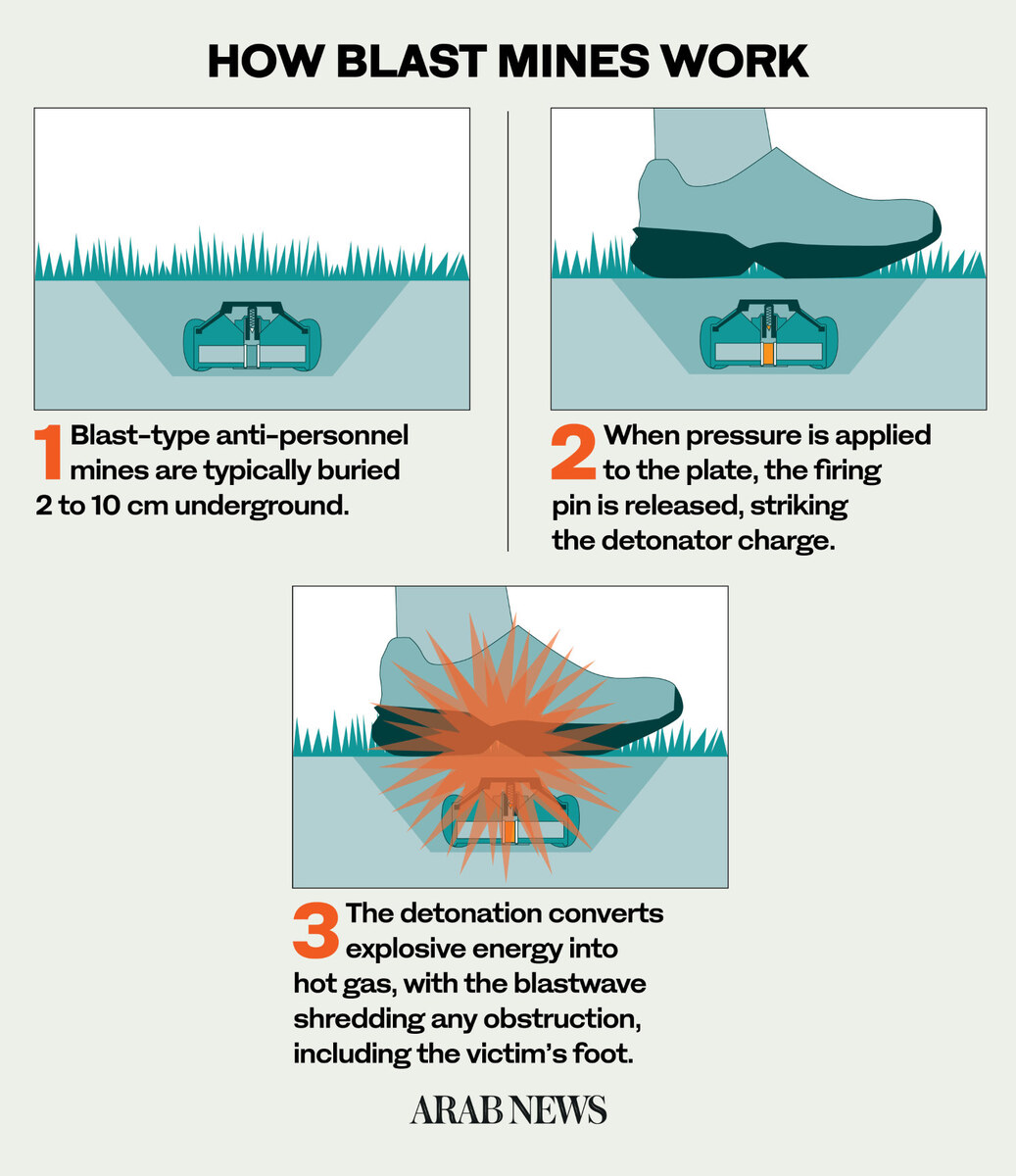
The Carter Center warned in a report published in February 2024 that the “scale of the problem is so large that there is no way any single actor can address it.”
Since Assad’s ouster, HALO has seen a 10-fold surge in calls to its emergency hotline in areas near the Turkish border where it operates.
“Every time our teams dispose of a piece of ordnance… people hear the explosion and they come running to say, ‘I found something in my house’ or ‘I found something on my land, can you come and have a look? Can you come and take care of that?” McCann said.
“We are hoping to be able to increase the size of the program as quickly as possible to deal with the demand.”
As the only mine clearance operator in northwest Syria, HALO is struggling to keep up with surging demand. With funding for only 40 deminers, the organization is desperately understaffed, HALO’s Syrian Arab Republic program manager Damian O’Brien said in a statement.
HALO urgently needs emergency funding “to help bring the Syrian people home to safety,” he said. “Clearing the debris of war is fundamental to getting the country back on its feet,” he added.
The urgency of clearing unexploded ordnance in Syria has grown as displaced communities, often unaware of those hidden dangers, rush to return home and rebuild their lives.
“One of the problems we’re finding is the people are coming back now,” McCann said. “They want to plant the land for spring. They want to start getting the land ready because they’re going to need the income to rebuild.
“Millions of homes have been either destroyed by fighting, or they’ve been destroyed by the regime that stripped out the windows and the doors and the roofs and the copper pipes and the wiring to sell for scrap.”
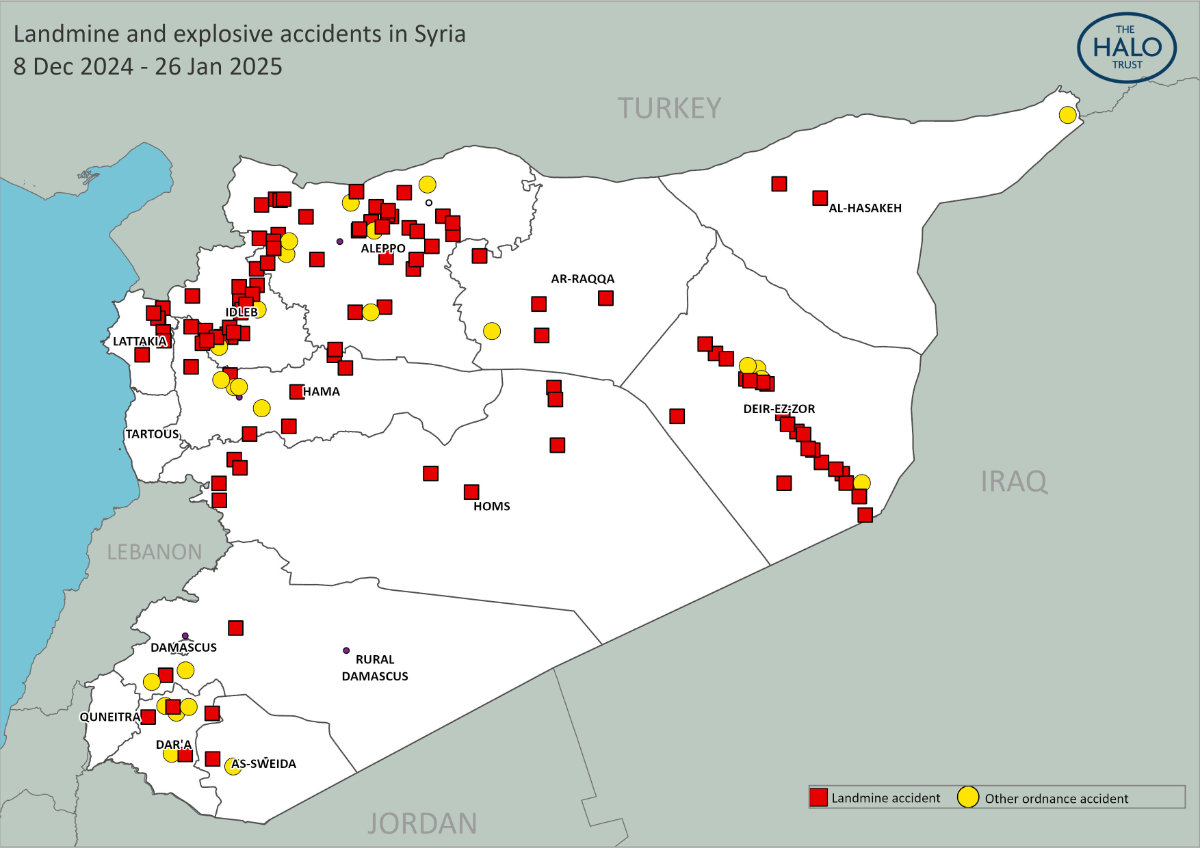
The war in the Syrian Arab Republic created one of the largest displacement crises in the world, with more than 13 million forcibly displaced, according to UN figures. With Assad’s fall, hundreds of thousands returned from internal displacement and neighboring countries.
And as host countries, including Turkiye, Lebanon and Jordan, push to repatriate Syrian refugees, UNICEF’s Chaiban warned in January that “safe return cannot be achieved without intensified humanitarian demining efforts.”
HALO’s O’Brien warned in December that “returning Syrians simply don’t know where the landmines are lying in wait. They are scattered across fields, villages and towns, so people are horribly vulnerable.”
He added: “I’ve never seen anything quite like it. Tens of thousands of people are passing through heavily mined areas on a daily basis, causing unnecessary fatal accidents.”
Unless addressed, these hidden killers will impact multiple generations of Syrians, causing the loss of countless lives and limbs long after the conflict has ended, the Carter Center warned.
Economic development will also be disrupted, particularly in urban reconstruction and agriculture. Environmental degradation is another concern. As munitions break down, they leach chemicals into the soil and groundwater.
But safely demining an area is costly and securing adequate funding has been a challenge. Mouiad Alnofaly, HALO’s senior operations officer in the Syrian Arab Republic, said disposal operations could cost $40 million per year.
Faced with these limitations, locals eager to cultivate their farmland are turning to unofficial solutions, hiring amateurs who are not trained to international standards, resulting in more casualties, McCann warned.
“People are returning and trying to plant, and so we’re hearing reports that they’re hiring ex-military personnel with metal detectors to do some sort of clearance of their land, but it’s not systematic or professional,” he said.
“I met a man a few days ago who said his neighbor had hired an ex-soldier with a metal detector to find the mines on his land. The man (ex-soldier) was killed straight away, and the neighbor was injured.”
McCann emphasized that a field cannot be considered safe until every piece of explosive debris and every landmine has been removed.
“If there are 50 mines in a field, and somebody finds 49 of them, the field still cannot be used,” he said. “You can only hand back land when you are 100 percent confident that every single mine is gone.
“So, even in places where some people are removing mines, we don’t know if all of them have been cleared, and we’ll have to do clearance again in the future.”
Although the northwest of the Syrian Arab Republic is riddled with unexploded ordnance, locals remain resolute in their determination to stay and rebuild their lives — a decision that is likely to lead to an increase in accidents.
“We think the number of accidents will increase because a lot of people don’t want to leave their displaced communities in Idlib in the winter,” McCann said. “They’re waiting for the weather to improve.”
In the village of Lof near Saraqib, one resident HALO encountered returned to work on his land just hours after the charity’s team had neutralized an unexploded 220mm Uragan rocket. Had it detonated, it would have devastated the village.
“We took the rocket, dug a big hole, and evacuated the whole village,” McCann said. “We used an armored front loader to take it to this demolition site in the countryside.
“By the time we came back to the village, the landowner had started to rebuild his house where the rocket had been. He couldn’t touch it (before), and the rocket had been there probably since 2021.
“But within three or four hours of us removing the rocket, he had started to rebuild.”
Among the most common unexploded ordnance found in the northwest Syrian Arab Republic are TM-62 Russian anti-tank mines and ShOAB-0.5 cluster bombs.
Despite HALO’s 35 years of work in safely clearing explosive remnants of war, the scale of the problem, compounded by a lack of adequate resources, remains a significant challenge.
“To cover the whole country, there will have to be thousands of Syrians trained and employed by HALO over many years,” said program manager O’Brien.
And until international and local efforts are effectively coordinated to neutralize this deadly threat, the lives of countless civilians, particularly children, will continue to be at risk.
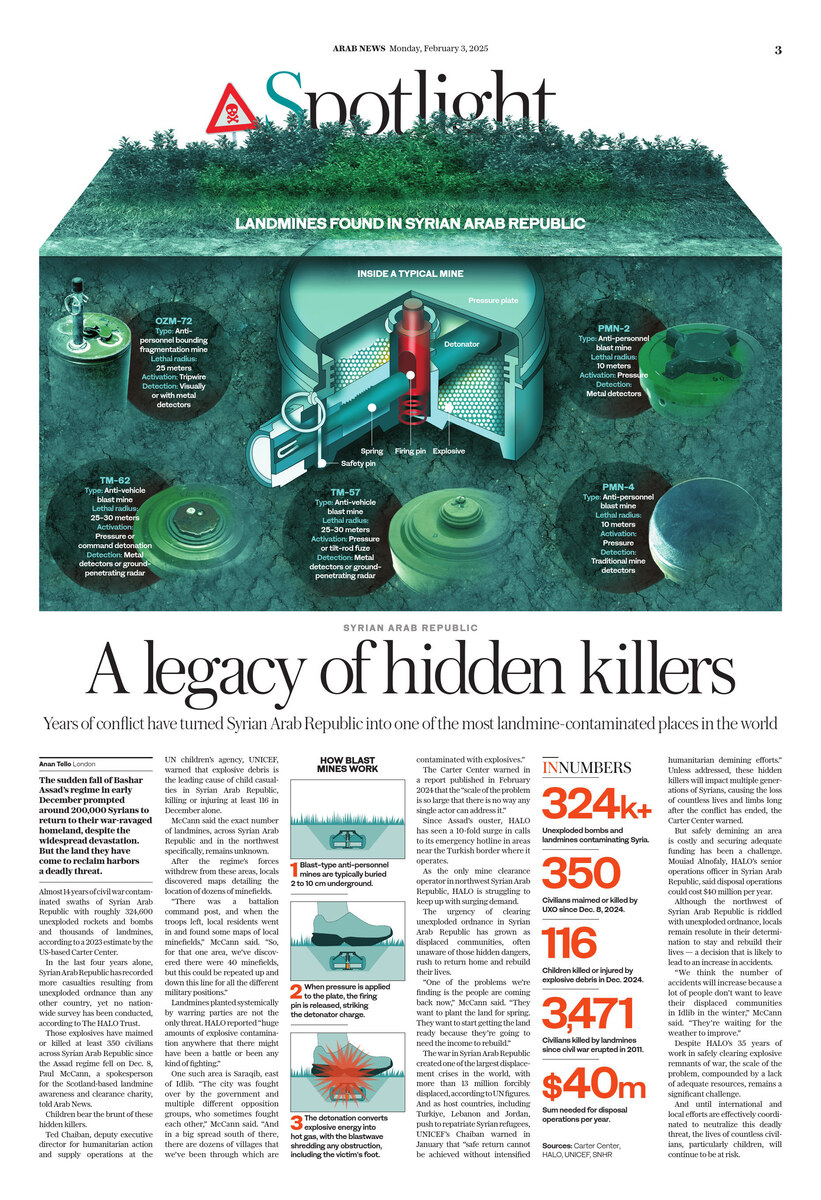
Drone attack targets Iraq’s northern Khor Mor gas field, security sources say

- There was no damage to the field or Dana Gas company and production is normal, the Kurdish Regional Government’s Ministry of Natural Resources reported
BAGHDAD: A drone attack targeted the Khor Mor gas field in Iraq’s Kurdistan region on Sunday, two security sources told Reuters.
There was no damage to the field or Dana Gas company and production is normal, the Kurdish Regional Government’s Ministry of Natural Resources reported.
The Pearl Consortium, United Arab Emirates energy firm Dana Gas (DANA.AD), and its affiliate, Crescent Petroleum, have the rights to exploit Khor Mor.
No group has claimed responsibility for the attack.
Kuwait’s defense, interior minister meets Egyptian president in Cairo

- Sheikh Fahd, President Abdel Fattah El-Sisi discuss relations between Kuwait, Cairo
- Sheikh Fahd on 2-day official visit to Cairo
LONDON: Sheikh Fahd Yousef Saud Al-Sabah, Kuwait’s minister of defense and the minister of interior, met Egyptian President Abdel Fattah El-Sisi on Sunday during a two-day official visit to Cairo.
Sheikh Fahd conveyed greetings to El-Sisi from the Emir of Kuwait Sheikh Mishal Al-Ahmad Al-Jaber Al-Sabah, and Crown Prince Sheikh Sabah Al-Khaled Al-Hamad Al-Mubarak Al-Sabah.
Sheikh Fahd and El-Sisi discussed relations between Cairo and Kuwait and the enhancement of collaboration in various fields. They also discussed recent developments in regional and international affairs, the Kuwait News Agency reported.
Ghanem Al-Ghanem, Kuwait’s ambassador to Egypt, attended the meeting, along with several senior officials.
Sheikh Fahd, who also serves as first deputy prime minister, has started a three-leg Middle Eastern tour, which includes visits to Jordan and Oman.
His first official visit to Egypt took place in June, during which he met Mahmoud Tawfik, the Egyptian interior minister, and Mohamed Zaki, the former minister of defense.
Netanyahu agrees to begin talks on 2nd phase of ceasefire

- Hamas and Islamic Jihad have so far handed over 18 hostages to the International Committee of the Red Cross, the Israelis among them, in exchange for hundreds of Palestinian prisoners, many of them women and children
JERUSALEM: Israeli Prime Minister Benjamin Netanyahu will begin talks on a second phase to the Gaza ceasefire in Washington on Monday, his office said hours after the completion of the fourth hostage-prisoner exchange of the truce.
Netanyahu spoke with the US President’s Middle East envoy Steve Witkoff, on Saturday and agreed that negotiations would “begin when they meet in Washington.”
A date for formal talks involving mediators and delegations from Hamas and Israel has not been set, with the 42-day first phase due to end next month.
Netanyahu’s office said Witkoff would talk to key mediators before discussing with the Israeli premier “steps to advance the negotiations, including dates for delegations to leave for talks.”
The second phase is expected to cover the release of the remaining captives and to include discussions on a more permanent end to the war, something several members of Netanyahu’s government oppose.
FASTFACT
The second phase is expected to cover the release of the remaining captives and to include discussions on a more permanent end to the war, something several members of the Israeli government oppose.
As part of the first phase, Hamas on Saturday freed three Israeli hostages in exchange for more than 180 Palestinian prisoners released from Israeli custody.
Hostages Ofer Kalderon and Yarden Bibas were paraded on stage by militants before being handed over to the Red Cross in the southern Gaza city of Khan Younis.
US-Israeli Keith Siegel was freed in a similar ceremony at Gaza City’s port in the north.
The Israeli military later confirmed that all three were back in Israel.
Israeli campaign group the Hostages and Missing Families Forum hailed their release as “a ray of light in the darkness.”
“I hope that this is a sign of the rebirth of the people of Israel, not just of Ofer, not just of the hostages,” Kalderon’s uncle Shemi said, overcome with emotion.
Later in the day, a bus carrying released Palestinian prisoners was greeted by a cheering crowd in the West Bank city of Ramallah, while three other buses were met by hundreds of well-wishers in Khan Younis.
“I need a great deal of composure to control myself, to steady my nerves, to absorb this overwhelming moment,” said one released prisoner, Ata Abdelghani, as he prepared to meet his now 10-year-old twin sons for the first time.
After holding the hostages for more than 15 months, militants in Gaza began releasing them on Jan. 19 under the terms of the ceasefire deal with Israel.
Hamas and Islamic Jihad have so far handed over 18 hostages to the International Committee of the Red Cross, the Israelis among them, in exchange for hundreds of Palestinian prisoners, many of them women and children.
A total of 183 prisoners were freed Saturday, all of them Palestinian except for one Egyptian.
The ceasefire’s six-week first phase hinges on the release of a total of 33 hostages in exchange for around 1,900 people, mostly Palestinians, held in Israeli jails.
Hundreds had gathered in the Tel Aviv plaza dubbed “Hostage Square” to watch live television coverage of the latest releases.
Sighs of relief ran through the crowd as the three were freed, though the mood was mostly somber. Ahead of the releases in Khan Younis and Gaza City, scores of masked Hamas fighters stood guard in an apparent effort to prevent large crowds from forming.
It was a sharp contrast to the chaotic scenes that accompanied Thursday’s handover, which prompted Israel to delay its release of Palestinian prisoners in protest briefly.
After Saturday’s hostage release, Gaza’s key Rafah border crossing with Egypt was reopened, with the Health Ministry in the Hamas-run territory saying 50 Palestinian patients in need of specialist treatment had passed through.
Egyptian state-linked channel Al-Qahera News showed footage of the first evacuees, who included 30 children with cancer.
Gaza hospitals director Muhammad Zaqout said he hoped the numbers would increase.
“We now have 6,000 cases ready to be transferred, and more than 12,000 cases that are in dire need of treatment,” he said.
Rafah was a vital entry point for aid before the Israeli military seized the Palestinian side of the crossing in May.
US President Donald Trump, who has claimed credit for the ceasefire deal, is expected to host Netanyahu at the White House on Tuesday.
South Lebanon residents describe ‘terrifying’ border destruction

- Lebanese military forbids unauthorized return to villages amid continued Israeli military activity
- Israeli forces remain in parts of the border region after extension of ceasefire withdrawal period
BEIRUT: Residents of the southern Lebanese border towns of Aitaroun, Houla, and Yaroun returned to inspect their homes on Sunday.
Returnees described “huge and terrifying destruction” in Aitaroun and Houla. Tarif Salami, a member of the Aitaroun Municipal Council, stated: “The destruction in the neighborhoods of Aitaroun is beyond description, and we can say that the situation in the town is catastrophic.”
The Israeli forces that invaded the villages remain in place and continue to threaten to open fire on returning locals.
They also detained a fisherman from the Juhair family in Ras Al-Abiad, near Naqoura, while he was sailing with his brother on their boat.
Roads from Wadi Al-Hojeir and Wadi Al-Salouqi were opened on Sunday morning to convoys of Lebanese wishing to return to their homes.
The Lebanese Armed Forces are already present in some villages, and residents from others were escorted on their journey back.
Checkpoints have been established at village entrances to manage the influx of residents and ensure the safety of returnees.
Pro-Hezbollah caretaker Labor Minister Mustafa Bayram said southern residents would not wait for a statement to return to their villages.
“We uphold the legitimacy of the Lebanese constitution, and people are the source of authority. Today, they are demonstrating authority and capability.”
The residents of Kfarkila waited in the corridor that connects their town to Deir Mimas, waving Lebanese flags.
They called for the withdrawal of Israeli forces, which conducted a large-scale attack in Kfarkila on Saturday night, targeting 10 houses.
A video shared on social media showed Lebanese soldiers dismantling the first fence in the area, allowing residents of Kfarkila to enter.
As the Lebanese Armed Forces redeployed in Aitaroun, residents returned to their town on foot, arriving in several neighborhoods despite the ongoing presence of Israeli forces on the outskirts.
Lebanese bulldozers cleared the roads to Yaron for residents to return, but Israeli forces fired on the crowd to halt their advance.
An Israeli military convoy launched two sound bombs at residents, but they remain determined to enter the town.
Community gatherings in support of Hezbollah have taken place in the town of Maroun Al-Ras. Residents spread out on the ground near the position of the Lebanese Armed Forces and raised the party’s flags on nearby trees. In response, Israeli forces fired shots into the air in an attempt to disperse the crowd.
Several residents of Adaisseh gathered at the town entrance and came under Israeli gunfire.
To apply popular pressure for the withdrawal of Israeli forces, the people of Beit Yahoun attempted to enter the town, accompanied by Lebanese soldiers, but came under gunfire.
Israeli forces have extended their occupation of the border region until Feb. 18, continuing to hinder the return of residents to their villages, much of which have been destroyed.
The Israeli strategy has made much of the border area uninhabitable for residents for the foreseeable future.
On Saturday night, Israeli soldiers burned houses in Adaisseh and Rab El-Thalathine. Israeli Army spokesperson Avichay Adraee warned residents of the area where the Israeli military is stationed, stating that “any individual who travels south is putting themselves at risk.”
The Israeli Army remains active in the area, restricting movement southward.
“For your safety, you are advised not to return to your residences in the affected areas until further notice.”
Adraee stated that the deployment process was progressing gradually.
In some sectors, he said that the process was delayed and needed more time to ensure that Hezbollah could not regain its presence on the ground.
He indicated that Israel would continue its current approach and would soon inform residents about the areas to which they could return.
“Until then, do not allow Hezbollah to return and exploit you in an attempt to cover up the devastating consequences of its irresponsible decisions at the expense of Lebanon’s security,” he said.
Israeli media reported that Lebanese residents returning to their villages were being observed by Israeli intelligence to detect any Hezbollah attempts to reposition in the area.
Israeli Channel 12 reported that military leaders in Israel recommended maintaining control over strategic positions in southern Lebanon until the full readiness of the Lebanese Army was verified.
Media reports indicate that the Israeli military was planning outposts in each of the border towns for what they describe as “defensive purposes.”





















